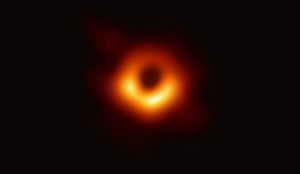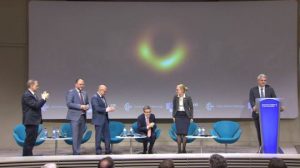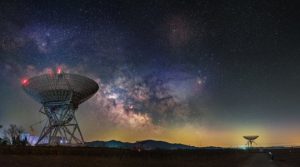A Black Hole Has been Pictured For The First Time In Human History

A black hole has been pictured for the first time in human history.
It was captured by the Event Horizon Telescope Collaboration (EHT) a vast array of telescopes all across the planet that were synchronised to work together. The image was revealed at a press conference in Brussels beamed around the world.
It shows the first direct visual evidence of the supermassive black hole in the center of the Messier 87 (M87) galaxy and its shadow. The image shows a bright ring formed as light bends in the intense gravity around a black hole that is 6.5 billion times more massive than the Sun.

The black hole’s boundary — the ‘event horizon’ from which the EHT takes its name — is around 2.5 times smaller than the shadow it casts and measures just under 40 billion km across. While this may sound large, this ring is only about 40 microarcseconds across — equivalent to measuring the length of a credit card on the surface of the Moon.
What is a black hole?
A black hole is a region of space from which nothing, not even light, can escape its gravity
Despite the name, they are not empty but instead consist of a huge amount of matter packed densely into a small area
There is a region of space beyond the black hole called the event horizon. This is a “point of no return”, beyond which it is impossible to escape the gravitational effects of the black hole
The M87 galaxy is one of the biggest and brightest in the known universe and is 53.49 million light years away from Earth. It is notable for shooting out a fast jet of charged subatomic particles that stretches for some 5,000 light years, which makes it the perfect target for the EHT project. Although the telescopes making up the EHT are not physically connected, they are able to synchronize their recorded data with atomic clocks which precisely time their observations.
These data were flown to highly specialized supercomputers — known as correlators — at the Max Planck Institute for Radio Astronomy and MIT Haystack Observatory to be combined. They were then painstakingly converted into an image using novel computational tools developed by the collaboration.
Professor Derek Ward-Thompson from the University of Central Lancashire, said:
‘This is a truly remarkable result. Obtaining an image of a black hole is not as easy as snapping a photo with an ordinary camera. However, the power created by linking up all these telescopes around the world is immense. It’s the equivalent of being able to see an object on the surface of the Moon that is only a few centimeters across.’ ‘Until now, this was the domain of science fiction and artist’s impressions. To be a part of the first team to image a black hole is an amazing feeling. This achievement stands right up there with any other feat in astronomy.’
The EHT project explained:
‘By linking together existing telescopes using novel systems, the EHT leverages considerable global investment to create a fundamentally new instrument with angular resolving power that is the highest possible from the surface of the Earth.’

Hearing about #BlackHoles this morning? Here’s a refresher on what a black hole IS. 🤔 It’s a place where a large amount of mass has been squeezed into a tiny space. The gravity is so strong that not even light can escape from a black hole. Learn more: https://t.co/lkbaYWv5cz pic.twitter.com/RVuuxpaJPG
— NASA (@NASA) April 10, 2019
-Metro

